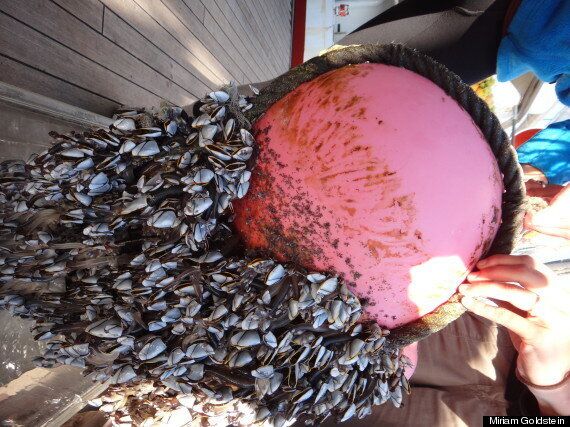When marine biologist Miriam Goldstein sliced open a barnacle's belly, she saw a tiny plastic bauble.
So she spilled a few hundred more barnacle guts -- and found humanity's synthetic soul.
"I think it speaks to the ubiquity of plastic in the North Pacific," she tells the Huffington Post Canada. "There is a little tiny piece of plastic spread out over thousands upon thousands of miles of the open ocean really far away from land. It is really an enormous problem."

Goldstein, an oceanographer at UC San Diego’s Scripps Institute of Oceanography plucked the barnacles from the notorious North Pacific Subtropical Gyre.
A vast expanse of plastic in the north Pacific, it's commonly called the Great Pacific Garbage Patch -- a sprawling indictment of our wasteful ways, where coffee cups, bags, toys, and whatever-you-wrapped-your-sandwich-in clumps together in the North Pacific.
And it's increasingly finding its way into the food chain.
"There are whales and sea birds and sea turtles and fish all eating plastic," Goldstein says. "It's not surprising that barnacles are too."
Gooseneck barnacles -- Goldstein describes them as "essentially a little shrimp living upside down in a shell and eating with their feet" -- may be able to handle the plastic better than other marine animals.
"It really appears from looking at their guts that the plastic was just passing through," she adds.
In that case, the barnacles would be doing us no favours, as the plastic isn't broken down.
Sea turtles and birds, on the other hand, show well-documented signs of intestinal blockage after eating plastic. Many simply starve.
Barnacles, on the other hand, are much more likely to serve as quiet, gnawing condemnation of our plastic ways.
"I think we should be concerned that the ocean is actually covered in a sprinkling of plastic particles," she says. "The barnacles are reflecting the fact that there is a tonne of plastic in the open ocean.
"We need to do more to understand what that might mean. We don don't know. This is a pretty new and large-scale and depressing problem. Plastic has only been around as a consumer product since the 1950s."
It all reminds her of an ancient culture that "used to think that the soul was in the stomach"
Only trouble is it's our soul.
Also on HuffPost
